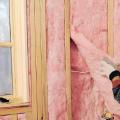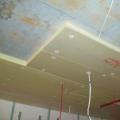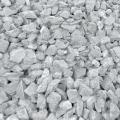Clay for masonry stoves
Many fairy tales and epics were dedicated to the Russian stove. She is the personification of comfort and warmth in the house, a nurse. It was a multifunctional building in the center of a peasant hut. Everyone knew that in construction it is necessary clay for masonry and cladding ovens. Such a stove served the owners not only for cooking and heating; special beds were built on the stove, on which they dried outer clothing and slept.
Uniform heat warmed the whole body. People suffered from colds less often and practically did not suffer from arthrosis and osteochondrosis. The air in the room was dry, there was no humidity or mold. The heated stove gave off heat for a long time, maintaining a comfortable temperature.
A poorly built stove was a deadly threat to the occupants of the home. It could become a source of fire and cause carbon monoxide poisoning. One hut could burn down the entire village, so stove makers who did their job well were given all sorts of honors.
Furnace business in Rus' was profitable. In our time, it has not lost its relevance; on the contrary, demand is growing every year. These are adherents of a healthy lifestyle who want to live away from civilization. Some are forced to switch to stove heating because many villages are not gasified, while others do not have the money to pay for gas heating.
In recent years, one of the fashionable trends in country house construction and design has been a variety of stoves as decorative items. Beautifully built, tiled with various patterns or tiles, it is an interior decoration and a source of pride for the owner.
Laying out the oven is quite a labor-intensive task and requires skills and knowledge.
Such a responsible task cannot be entrusted to ignorant people who do not know the intricacies of the profession. This skill develops over the years. Through trial and error, stove makers honed their skills and did not share their secrets with anyone. These secrets cannot be found in any manual. Previously, this business was passed on from father to son or relative.

One of the secrets was the selection of masonry stove mortar. This was the basis of the basics, because the durability of the stove and its functional qualities depended on the solution.
Depending on the purpose of the furnace, a specific solution was used. Various parts in the design also required a specific mixture composition. The firebox required refractory bricks and mortar, and a durable, moisture-resistant composition for the foundation. Knowledge of these features was necessary, because the life and health of the owners and the durability of the structure depended on it.
An experienced craftsman uses at least 3 solutions in his work to build a stove. This is due to the fact that the oven shrinks and if the binding solution is chosen incorrectly, it can simply crack and fall apart. If the tightness of the furnace walls is broken, people can be poisoned by carbon monoxide.
In a furnace firebox, the flame temperature rises above 1000 degrees, and various combustion products are formed. Therefore, only fire-resistant materials should be used. They can withstand not only elevated temperatures, but also the effects of combustion products. The firebox must be absolutely sealed and durable.
The universal mortar used in laying the stove is clay.

Advantages of clay mortar:
- It is simple and cheap, especially if the stove maker finds the clay himself;
- Fire resistance;
- Resistance to aggressive combustion products;
- Withstands temperatures up to 1100 degrees;
- Strength when drying; together with the brick, an almost monolith is formed;
- You can re-lay the stove, the structure of the brick is not disturbed;
- The solution is stored indefinitely. When dry, you can soak it and use it again at any time;
- Sustainable waterproofing agent.
The disadvantages are:
- When wetted, clay masonry gets wet and falls apart, so this masonry is only suitable in enclosed spaces or plastered using a moisture-resistant mortar;
- You need to know which clay is suitable for what, and be able to find it;
- Preparing a clay solution requires skill and time.
Clay is a sedimentary rock from the group of aluminosilicates combined with carbonate particles. Silicon gives strength, and aluminum oxide in combination with water gives plasticity. Various minor impurities give a variety of colors. Clay comes in white, blue, green, red, yellow, brown and black.
This is the oldest building material used by man. It is difficult to overestimate the role of this inconspicuous mineral in the history of human development. People appreciated and understood its advantages and learned to use it for their own purposes. These are buildings, stoves, dishes, they even wrote on clay tablets that have survived to this day.
Clay is used in medicine, cosmetology, the paper industry, in the production of dishes and ceramics, construction and other industries.

Clay for masonry stoves
Clay is a common mineral on Earth. Outcrops of layers are visible almost everywhere. Despite this, not every clay is suitable for baking.
How to choose the right one?
The complex of basic qualities is determined by fat content. Clay can be oily, medium fat and lean.
- Oily is plastic, but when it dries it cracks and shrinks greatly. This leads to deformation and destruction of the structure.
- Medium fat clay is the best option. It has good adhesive properties, durable, heat-resistant, and hygroscopic. When dry, it gives a moderate slump and does not crack.
- Lean clay has low adhesive properties. It is dry, cracks quickly, and the masonry crumbles.
Finding good clay is a great success. Good layers lie at a depth of 5 meters. The surface ones are heavily contaminated with humus and contain a high content of sand impurities. This is loamy, thin soil. She's not fit for work.

Under the loam layer there is a clay formation. The thicker the formation, the better. The lower layers are the fattest clay, but it is also not pure. It is better to take from the middle layers with the least content of organic matter and impurities.
Sometimes bentonite comes across. This mineral resembles clay, but it has neither heat resistance nor gas tightness. Bentonite is hygroscopic. It swells greatly to form a bentonite gel. This is a completely unsuitable material for masonry. It is used in the food industry and winemaking to clarify wine and remove fusel oils.
Clay research.
Take a lump of clay in half a fist. Wet it, knead it until soft, and slowly squeeze it between two perfectly flat planes. If the lump quickly cracks, then the clay is of poor quality. Cracks appeared after the lump was compressed by one third, then such clay is taken home for further work in a volume of at least 5 kilograms.
Research on the properties of clay at home.
Water hardness matters. Use only soft or, in extreme cases, medium-hard water.
The sand used for the firebox is quartz; for the rest we use regular construction yellow sand. First, the sand mixture is sown through a fine wire sieve. Then they are thoroughly washed with water to remove organic matter - various organisms that like to live in the sand. Their presence in masonry mortar is undesirable, as this deteriorates its quality.

The next step is to find out the proportions of the components of the mixture.
We divide the entire volume of clay brought into two parts. We set aside part and divide the second into 5 parts. It is better to label the dishes. Distribute the clay evenly into a marked container and ferment it with water, adding a quarter of the amount of clay. It becomes limp within 24 hours, after which we mix it, press it through a mesh material with 3 mm cells, and let it sit for 1 day. Then drain the top layer of water and add sand, starting with the second cup - a quarter of the sand, 3 cup ˗ half the sand, 4 cup ˗ three quarters, 5 cup ˗ one to the full of the volume of clay. The first cup contains only clay. You need to stir thoroughly until the mixture is homogeneous.
We make samples from the resulting solution:
- Sausages or flagella 30 centimeters long, no thicker than a finger ˗ 2 pieces.
- Roll into a ball with a diameter of 5 centimeters.
- We make a clay cake of medium diameter as thick as a finger.

We label the samples. Clay sausages are dried for three days, balls and cakes for up to twenty days. The samples are dried in the shade.
When stretching or wrapping flagella around a stick:
- normal clay - only the crust cracks and the mass is damp;
- greasy ˗ the crust will crack or not crack;
- skinny clay ˗ flagellum breaks immediately.
The results of this experiment are not reliable. You must wait until the balls and cakes dry. We inspect dry samples for cracks, then drop them onto the floor from a height of 1 meter and see which ones have cracked. Those samples that withstood the impact are dropped again, but from a greater height. We select those samples that have passed the tests. This is the formula of the solution.

Using this formula, a test batch is made from the remaining clay and the adhesiveness of the solution is checked. If the solution is very liquid, the masonry will not be strong enough. If it is too thick, the seam will be too thick. Too liquid settles, drain the upper sludge (settled water) and measure the quantity. This volume is subtracted from the original volume of water for dilution.
A slightly greasy solution has adhesion. If you lower a trowel into it, then as it drains you will see a thin solution with streaks. If a continuous layer remains, then the clay is oily.
The final stage of the study.
Take two bricks. We lay a thin layer of mortar on the wide part of one and press it on top with a second brick. After 10 minutes we take one brick at a time. If the second brick does not fall off when shaken, then the composition is prepared efficiently.
It is better to mix clay solutions by hand. Vibration causes the mixture to become heterogeneous, with the formation of gaps, which will subsequently worsen the masonry.
The clay mixture for one oven is prepared as follows: First, the clay is fermented, then filtered, removing impurities, and then mixed with sand in a trough. Sand is added gradually. Stir with a paddle, pour into a barrel and allow to settle. Then the upper sludge is removed, the required amount of solution is taken into a bucket, and the rest is covered with damp sackcloth. This solution was stored for a long time.

Conscientious stove makers carefully and scrupulously selected clay, knew the properties, when and which one to use. They prepared the solution themselves, doing strength tests. Life and well-being in the house depended on their skills.
 Construction materials and list of works
Construction materials and list of works Proper insulation of a wooden ceiling in a private house
Proper insulation of a wooden ceiling in a private house What types of crushed stone are there?
What types of crushed stone are there?